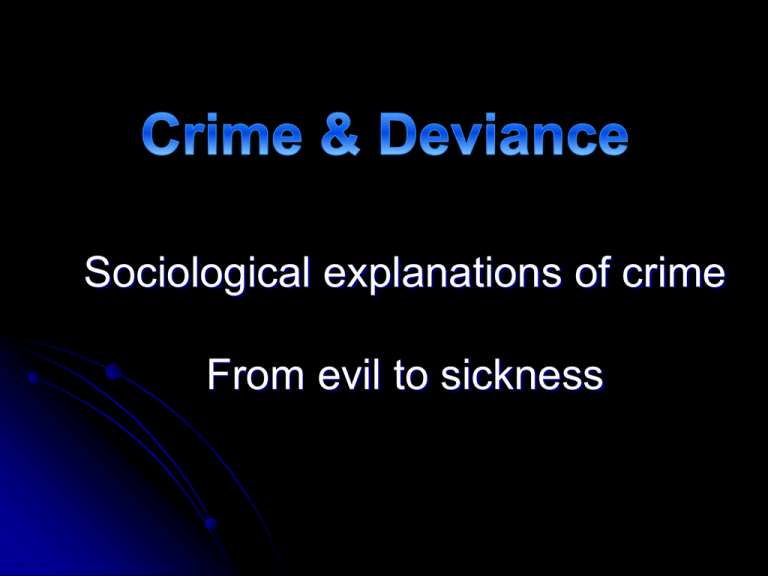Imagine a world where the rules you know, the values you hold dear, are turned on their head. A world where rebellion is celebrated, where defying norms becomes a badge of honor. This is the world of deviant subcultures, a fascinating and often misunderstood facet of human society. While the term “deviant” might conjure images of danger or chaos, understanding these subcultures offers a valuable lens through which to analyze the complexities of human behavior and social structures.

Image: study.com
Deviant subculture theory explores the dynamics of groups who actively reject mainstream norms, developing their own unique codes of conduct, beliefs, and values. It examines how these subcultures emerge, the social factors that influence their development, and their impact on both individuals and society at large. This theory is not about judging or condemning, but rather about understanding the motivations and experiences of those who choose to live outside the established societal framework.
The Foundation of Subculture Theory
The roots of deviant subculture theory can be traced back to the mid-20th century, with the work of sociologists like Albert Cohen and Richard Cloward and Lloyd Ohlin. Cohen, in his 1955 publication “Delinquent Boys,” argued that delinquent subcultures arise when lower-class youth are denied access to mainstream success and opportunity. This frustration, he argued, leads them to develop alternative systems of value, often characterized by rebelliousness and nonconformity.
Cloward and Ohlin built upon Cohen’s ideas, introducing the concept of “differential opportunity structures.” They suggested that access to illegitimate means of achieving success, such as criminal activities, also plays a crucial role in shaping subcultural formation. For example, a subculture focused on drug dealing might emerge where legitimate employment opportunities are scarce, and illegal activities offer a means to achieve financial success or social status.
Beyond the Labels: Understanding the Subculture Spectrum
It’s important to remember that the term “deviant” is not inherently negative. Subcultures can exist across a wide spectrum of behaviors, from seemingly harmless hobbies to groups engaged in illegal or controversial activities. These groups can be defined by shared interests, lifestyles, aesthetics, or even political ideologies.
For example, the punk rock subculture, which emerged in the 1970s, challenged mainstream norms through its anti-establishment lyrics, clothing styles, and DIY ethos. While some might view punk rock as a rebellious form of expression, it also served as a powerful voice for marginalized groups, offering a platform for social critique and activism.
The Power of Belonging: Subcultures as Social Networks
One defining feature of deviant subcultures is their strong sense of community and belonging. Individuals who feel alienated or excluded from mainstream society can find solace and support within these groups. This sense of belonging can be particularly important for young people who are struggling with identity formation or navigating the pressures of growing up.
The tight-knit nature of subcultures can also lead to the development of strong social bonds and shared rituals. For instance, the “goth” subculture, known for its dark aesthetics and fascination with the macabre, has a unique vocabulary, music, and fashion that serves as a powerful marker of group identity. These shared practices and symbols contribute to the sense of belonging and solidarity within the group.

Image: studylib.net
The Complexity of Deviance: Causes and Consequences
The study of deviant subcultures has revealed a complex interplay of individual and social factors that influence their development. Economic disparities, social inequality, and lack of opportunity can all contribute to the formation of subcultures that challenge mainstream norms. These groups often offer alternative solutions to problems that individuals may face, from finding a sense of identity to addressing social injustices.
However, it’s crucial to acknowledge the potential for these groups to engage in harmful or illegal activities. While not all deviant subcultures are involved in criminal behavior, some can foster environments where violence, substance abuse, or other forms of harm become normalized. This underscores the importance of understanding the context in which subcultures operate and the motivations of their members.
Navigating the Landscape: Applying Subculture Theory
Understanding deviant subculture theory is not just an academic pursuit. This theory can provide insights into a range of real-world issues, from promoting social cohesion to tackling crime and delinquency. It can help us understand the motivations behind individual choices, the dynamics of group behavior, and the complex interplay of social forces that shape our society.
For instance, law enforcement agencies can leverage this theory to develop more effective crime prevention strategies by targeting the root causes of deviant behavior in certain communities, rather than focusing solely on punishment. Education and social programs can also be designed to address the needs and concerns of young people who are at risk of joining deviant subcultures.
Deviant Subculture Theory
A Call to Understanding: Moving Beyond Judgement
Deviant subculture theory reminds us that society is not a homogeneous entity. It encourages us to move beyond simplistic stereotypes and judgments and explore the diverse perspectives and experiences that exist within our communities. By understanding the motivations and complexities of subcultures, we can foster a more inclusive and tolerant society, one that embraces difference and fosters dialogue rather than resorting to condemnation.
Instead of just labeling groups as deviant, we should strive to understand the social and individual factors that contribute to their formation. By looking beyond superficial judgments and engaging in critical thinking, we can move towards a more nuanced and empathetic understanding of the diverse tapestry that makes up human society.






